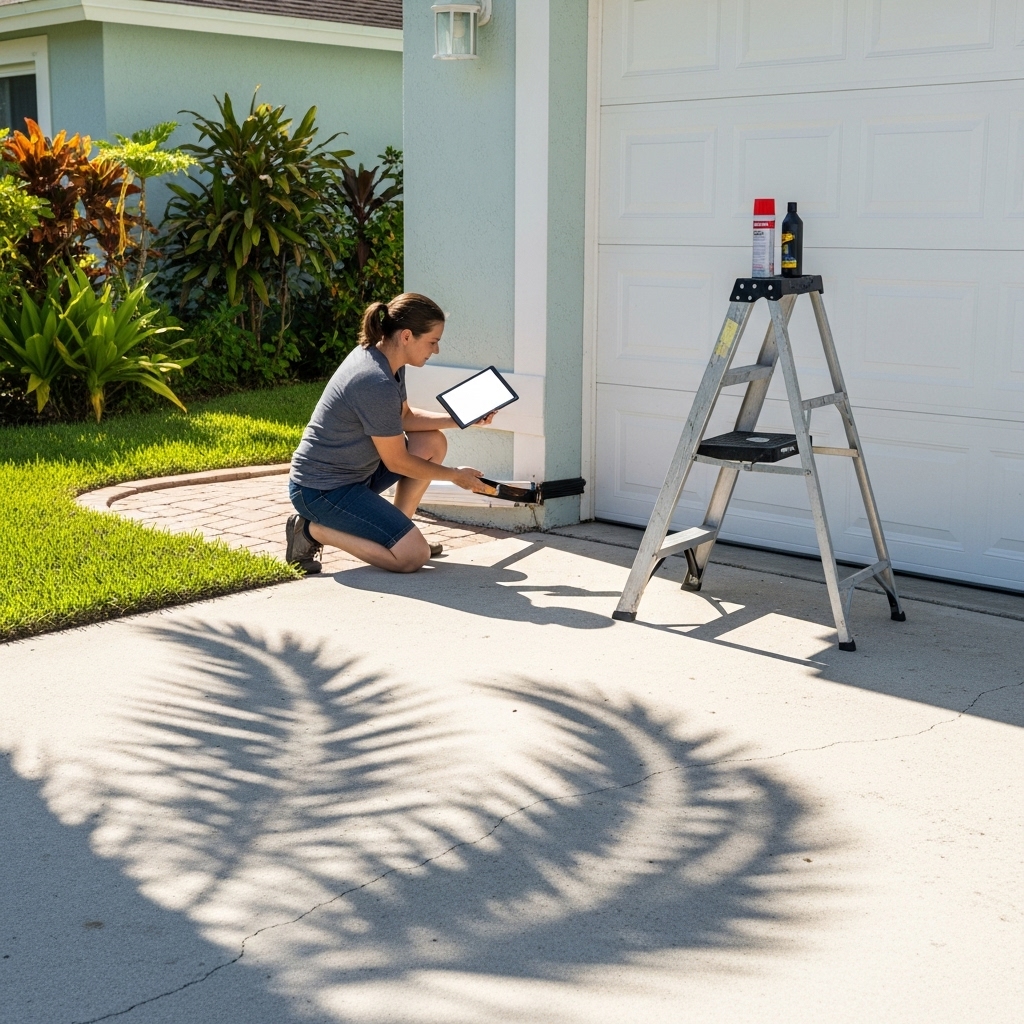Introduction: A Florida-Specific Checklist That Works
A well-maintained garage door improves safety, curb appeal, and day-to-day convenience. In Florida, your checklist must also combat humidity, intense sun, and seasonal storms that stress hardware and finishes. The best approach is to build a routine with clear tasks you can complete quickly, then reinforce it with periodic professional review. Use this comprehensive checklist to organize monthly, quarterly, and pre-storm steps and to identify the few jobs that should always be left to trained technicians. If you prefer to supplement your efforts with a dependable partner, plan periodic garage door maintenance to validate balance, alignment, and safety device performance.
This checklist is designed for homes across the state—from the Panhandle to the Keys—and adapts to both coastal and inland exposure. Customize timing based on your microclimate: coastal neighborhoods often need more frequent rinsing and corrosion control, while inland homes may focus on heat management and UV protection for seals.
Monthly Checklist
Visual sweep: With the door closed, walk inside and outside and look for dents, paint damage, rust at fasteners, or daylight leaking around seals. Open and close the door while watching for smooth travel and listening for squeaks, rattles, or scraping. If the door shifts side to side, pauses, or jerks, note the location of the problem for further inspection.
Rollers and hinges: Inspect rollers for wobble and smooth rotation. Nylon rollers with sealed bearings are ideal for humid areas. Look for cracked nylon or rust-stained bearing caps. Check hinges for tight screws and hairline cracks at the knuckles; tighten loose fasteners with moderate torque to avoid stripping.
Tracks and brackets: Confirm vertical tracks are plumb and horizontal tracks are level with adequate backhang support. Tighten bracket bolts and observe whether the track flanges are straight and free of dents. Wipe the track channel clean and dry; never apply lubricant inside the track.
Opener and mounts: Inspect the header bracket above the door and the ceiling mounts for the opener. Both should be solid, with no sway or vibration when the door operates. Verify the rail is straight, the chain or belt tension is within spec, and the trolley engages properly.
Photo-eyes and safety reversal: Clean the lenses with a soft cloth, confirm alignment, and test reversal by interrupting the beam mid-close. Place a 2×4 flat on the floor and confirm the door reverses upon contact. Adjust force and travel settings per the opener manual if needed, or seek help if the door does not reverse promptly.
Weather seals: Check the bottom seal and side/top seals for pliability and tight contact. Clean away sand and debris and apply silicone to keep rubber supple. Replace seals that are cracked, brittle, or failing to block light.
Lubrication: Apply a light, garage-door-specific lubricant to hinge pins, roller bearings, and spring bearings. Wipe away excess to prevent drips and grit buildup. Avoid all-purpose oils and heavy grease that can gum up in Florida heat.
Quarterly Checklist
Corrosion control: Inspect exposed metal—fasteners, torsion shaft ends, drums, and brackets—for early rust. Remove light rust with a non-scratch pad and apply a thin protective film appropriate for garage hardware. This is especially important in coastal neighborhoods subject to salt spray.
Balance and manual operation: Disconnect the opener with the door down and lift the door halfway. It should stay near position. If it drops or surges, the springs need professional adjustment. Reconnect the opener and test safety reversal again to confirm proper calibration.
Hardware integrity: Confirm reinforcement struts across door sections remain straight and tight. Check that the opener’s support angles are snug and that vibration is minimal during operation. Inspect cable condition near bottom brackets and drums; if you see fraying or crushed strands, stop using the door and call a professional immediately.
Cleaning and finish care: Wash the door panels with mild detergent and rinse thoroughly. Dry exposed hardware and seals. Touch up small paint chips to prevent moisture intrusion and rust at edges and fasteners. Keep the threshold clear so the bottom seal seats properly.
Pre-Storm Season Checklist
Wind code and reinforcement: Verify your door’s wind rating and reinforcement system. Inspect removable braces (if used) for complete hardware and practice installation. Tighten any loose fasteners on struts and brackets that work hardest under pressure.
Manual operation readiness: Test the emergency release and confirm that you can lift the door smoothly without the opener. If the door feels heavy or drifts, schedule service to correct the balance before storms arrive. Consider testing opener battery backup if your model supports it.
Seal integrity: Replace brittle or shrunken weather seals so wind-driven rain cannot penetrate. Clean the mating surfaces and ensure the bottom seal conforms to the slab. If the slab has settled, a taller seal profile may be necessary.
Coastal Adjustments to the Checklist
Weekly rinse: After breezy days that carry sea spray, rinse the door and hardware with fresh water. Dry critical hardware where feasible and re-lubricate pivot points if rinsing removes protective films.
Material choices: Favor sealed-nylon rollers with stainless stems, zinc-coated or stainless fasteners, and powder-coated hinges when replacing parts. These materials resist corrosion and keep the door quieter between service intervals.
Opener considerations: Keep the opener housing clean and closed, and confirm the header and ceiling mounts are secure. Marine air can corrode electronics over time; reducing vibration helps extend opener life.
Noise Troubleshooting
Squeaks typically indicate dry pivots; apply a light lubricant to hinge pins and roller bearings. Grinding may point to a bent track or damaged roller. Rattling suggests loose support angles or reinforcement struts. If noise persists after lubrication and tightening, have a technician inspect spring bearings and end bearings, which can wear silently until they cause significant chatter.
What Not to Do
Do not lubricate the track channel; it collects grit and slows the door. Do not attempt to adjust torsion springs or cables. Do not ignore frayed cables or cracked hinges. Do not bypass safety sensors to force the door closed. Avoid heavy grease and general-purpose oils that break down in heat and humidity.
When to Call a Professional
Seek expert help if the door is out of balance, if cables show damage, if tracks are visibly bent, or if the opener fails safety reversal tests. Professionals can also verify wind-load compliance, evaluate bearing health, and optimize opener force and travel settings. Pairing your checklist with periodic expert oversight keeps the system reliable and safe.
If you want a structured, documented review at key intervals—especially before the storm season or after major weather events—arrange dependable garage door maintenance to complement your routine. This partnership can catch subtle wear early, confirm proper calibration, and tailor recommendations to your location.
Frequently Asked Questions
Q: How often should I complete the monthly checklist? A: Once a month is ideal in Florida’s climate, with extra rinses for coastal homes after windy, salty days.
Q: What lubricant should I use? A: Use a light, non-detergent lubricant designed for garage door hardware on hinges and bearings, and silicone spray on weather seals. Avoid heavy greases.
Q: How do I know if my door is balanced? A: When disconnected from the opener, a balanced door will stay near the position you leave it at mid-travel. If it drops or rises quickly, the springs need adjustment by a professional.
Q: Should I lubricate the opener rail? A: Follow the manufacturer’s guidance. Chain drives may need a light application; belt drives usually do not. Do not over-apply.
Q: What if my door reverses randomly? A: Clean and align photo-eyes, shade them from direct sun, and verify wiring is secure. If the problem persists, an expert can evaluate sensor stability and opener calibration.
Q: How often should seals be replaced? A: Inspect quarterly and replace when they are brittle, cracked, or leaving gaps. Florida’s heat and sun often shorten seal lifespan.
Put the Checklist Into Action
Print or save this checklist and set reminders for monthly, quarterly, and pre-storm tasks. With a few focused minutes each cycle, you will keep your door quiet, safe, and storm-ready. For precision tasks, calibration, and validation of your work, schedule reliable garage door maintenance and enjoy confidence that your Florida home’s busiest door will perform when you need it most.

